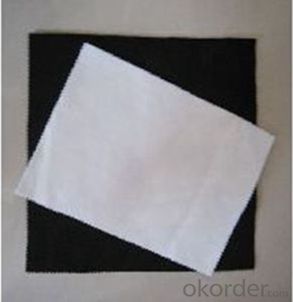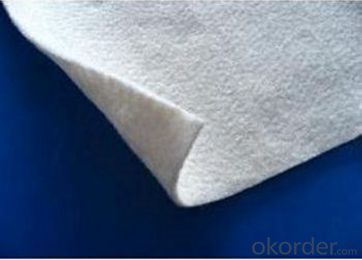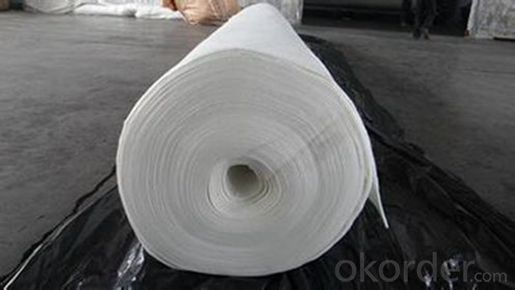Excellent Water Permeability Geotextiles with Good quality
- Loading Port:
- China main port
- Payment Terms:
- TT OR LC
- Min Order Qty:
- 4000 m²
- Supply Capability:
- 1000000 m²/month
OKorder Service Pledge
OKorder Financial Service
You Might Also Like
Item specifice
Product Description
Filtration:
It can be the filtration layer of the dykes, river canal, seacoast, concrete slope, retaining walls. At the same time of preventing the clay granule from passing, it allows the water and the gas pass through freely.
Separation:
The isolation of the railway dregs and the roadbed, roadbed and the soft base, surface of the airdrome and parking lot and the groundsill, different dam materials. It isolates the soil and the gravel of two kinds different granule pathway from the groundsill or other buildings.
Reinforcement:
The highway, railway, soil-stone dam, breakwater, airport, backfill soil of retaining wall, slope protection, etc in which distributes the earth stress, prevents the side-displacement of the earth body and improves the earthbody stability.



Packaging & Shipping
Packing: PLASTIC FILM INSIDE, AND WOVEN BAG OUTSIDE
Shipping: About 15 days after receipt the deposit
geotextile fabric
permeability,filtration,easy for construction
ISO and CE certificate
Good quality and competitive price
Our Service
Quality assurance
1.On a regular basis or as per your request,we entrust national testing agencies to conduct quality inspections
2. Strictly in accordance with the ISO9001-2008 international quality system standard,we monitor and manage the whole process throughout production,quality testing,and measurement to ensure product quality
3. For quality-related construction delay or substandard construction(except for damage or losses due to customer’s responsibility or irresistible natural disasters),we have refunding,replacement,and repair services.We will respond to customers’ feedbacks on quality issues within 24 hours.
After-sales service
1.In order to provide customers with comprehensive technical support,we will provide technical and other related information upon request in a timely manner.
2.In required,we will appoint specialized technicians to the construction site to give technical trainings to construction people,and offer technical guidance throughout the whole construction process.
3.For damage due to shipment and delivery,after we receive the complaint,we will check the issure through provided pictures and videos.If our responsibility is confirmed,we wil offer free replacement.
4.When the construction is completed,as your request,our technical staff may participate in the final acceptance.
FAQ:
Q: What kind of payments does jenor support?
A: T/T, L/C, Cash are accepted.
Q: Do you charge for the samples?
A: Accordeing to our company policy, the samples are free, we only charge the freight fee. And we will return the freight fee during the next order.
Q: Can you produce according to customers' design?
A: Sure, we are professional manufacturer, OEM and ODM are both welcome.
Q: Do you have other products?
A: Yes, please check the pictures:
- Q:What are the limitations of using geotextiles in high-water flow conditions?
- One limitation of using geotextiles in high-water flow conditions is their potential to clog and become less effective over time. The continuous exposure to flowing water can lead to the accumulation of sediments and other debris, which can reduce the permeability of the geotextile and hinder its ability to drain water efficiently. Additionally, in extreme high-flow situations, geotextiles may not provide sufficient strength and stability to withstand the forces exerted by the water, potentially leading to failure or damage. Therefore, careful consideration and proper design are essential when using geotextiles in high-water flow conditions.
- Q:Sng400-2.5gb / t-1998 geotextile is what the specifications
- Two cloth a film, wish smooth
- Q:How do geotextiles affect soil settlement?
- Geotextiles can help reduce soil settlement by providing reinforcement and stabilization. They act as a barrier that distributes the load from structures evenly, preventing differential settlement. Additionally, geotextiles improve soil drainage, allowing excess water to flow through while retaining the soil particles, which further aids in minimizing settlement.
- Q:How do geotextiles help with filtration in geosynthetic clay liners?
- Geotextiles play a crucial role in enhancing filtration in geosynthetic clay liners (GCLs) by acting as a barrier that prevents fine particles from migrating into the clay layer. The geotextile acts as a filtration medium, allowing water to pass through while retaining the soil particles. This helps to maintain the integrity and effectiveness of the GCL by preventing clogging and maintaining the desired hydraulic conductivity.
- Q:What are the considerations for geotextile selection in railroad projects?
- When selecting geotextiles for railroad projects, several considerations need to be taken into account. Firstly, the geotextile should have sufficient strength to withstand the loads and stresses imposed by train traffic. It should also possess excellent puncture resistance to ensure long-term durability. Additionally, the geotextile should have good filtration properties to prevent fine particles from entering the subgrade and causing drainage issues. It is important to consider the geotextile's permeability, as it should allow for adequate drainage to maintain the stability of the railway track. Lastly, the geotextile's compatibility with other materials used in the project, such as ballast or subgrade soils, should be evaluated to ensure proper functioning of the system.
- Q:Can geotextiles be used for soil stabilization?
- Yes, geotextiles can be used for soil stabilization. Geotextiles are commonly used to reinforce and stabilize soil by providing strength, preventing erosion, and promoting drainage. They are often used in various civil engineering applications such as road construction, embankments, and retaining walls to improve the stability and longevity of the soil.
- Q:Geotextile geotextile geotextile construction geotextile specific application
- Geotextile in the construction of the main building is to protect the concrete: 1, in the summer construction of geotextile is to protect the concrete in the water; 2, in the winter construction of geotextile that can protect the concrete moisture also play a role in insulation.
- Q:What are the applications of geotextiles in civil engineering?
- Geotextiles have a wide range of applications in civil engineering. They are commonly used in road construction, where they provide reinforcement and stabilization to the soil, preventing the formation of cracks and potholes. Geotextiles are also used in the construction of embankments and retaining walls, where they provide erosion control and improve soil stability. Additionally, they are used in drainage systems to filter out fine particles and prevent clogging. Overall, geotextiles play a crucial role in enhancing the performance and durability of various civil engineering structures.
- Q:How are geotextiles maintained?
- Geotextiles are typically low-maintenance materials that require minimal upkeep. Routine maintenance for geotextiles involves inspecting them periodically to ensure they are functioning properly and remain free from any damage or clogging. If any issues or damage are identified, appropriate repairs or replacements may be necessary. Overall, geotextiles are designed to be durable and long-lasting, requiring little ongoing maintenance.
- Q:What are the quality control measures for geotextile manufacturing?
- Quality control measures for geotextile manufacturing typically include the following steps: 1. Raw material inspection: Thoroughly assessing the quality, specifications, and properties of the raw materials used in geotextile manufacturing, such as fibers and polymers. 2. Process control: Implementing strict control over various manufacturing processes, including extrusion, weaving or non-woven production, and coating, to ensure consistency, accuracy, and adherence to specifications. 3. In-line testing: Conducting regular tests and inspections during the manufacturing process to monitor key parameters such as weight, thickness, tensile strength, porosity, and permeability. 4. Sample testing: Randomly selecting samples from each batch and subjecting them to comprehensive laboratory tests to verify compliance with industry standards and project requirements. 5. Quality audits: Conducting periodic audits of the manufacturing facility to assess the overall quality management system, equipment calibration, personnel training, and adherence to standard operating procedures. 6. Final product inspection: Thoroughly examining finished geotextile rolls or panels for any defects, such as tears, holes, or inconsistencies in physical properties, before packaging and shipping. 7. Documentation and traceability: Maintaining detailed records of all quality control activities, including test results, inspection reports, and batch numbers, to ensure traceability and facilitate recalls if necessary. By implementing these quality control measures, geotextile manufacturers can consistently produce high-quality products that meet the performance requirements and specifications of various geotechnical applications.
1. Manufacturer Overview |
|
|---|---|
| Location | |
| Year Established | |
| Annual Output Value | |
| Main Markets | |
| Company Certifications | |
2. Manufacturer Certificates |
|
|---|---|
| a) Certification Name | |
| Range | |
| Reference | |
| Validity Period | |
3. Manufacturer Capability |
|
|---|---|
| a)Trade Capacity | |
| Nearest Port | |
| Export Percentage | |
| No.of Employees in Trade Department | |
| Language Spoken: | |
| b)Factory Information | |
| Factory Size: | |
| No. of Production Lines | |
| Contract Manufacturing | |
| Product Price Range | |
Send your message to us
Excellent Water Permeability Geotextiles with Good quality
- Loading Port:
- China main port
- Payment Terms:
- TT OR LC
- Min Order Qty:
- 4000 m²
- Supply Capability:
- 1000000 m²/month
OKorder Service Pledge
OKorder Financial Service
Similar products
New products
Hot products
Hot Searches
Related keywords
































